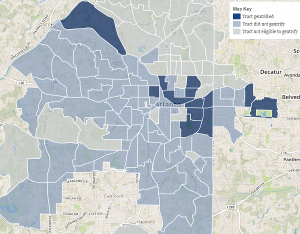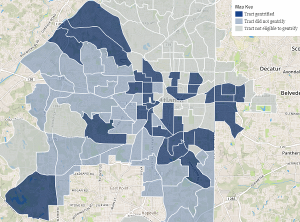Annotated Bibliography #4
Bracey , Trayon . “The Big Discussion with Gentrification in Atlanta .” The Lifestyle Room . 20 Jan 2016. Web. 24 Feb 2016. <http://artrevmagazine.weebly.com/lifestyle/the-big-discussion-with-gentrification-in-atlanta.
The Big Discussion with Gentrification is a topic discussed with Travon Bracey published by The Atriv Magazine in the Lifestyle section. This article discusses His personal experiences of living in Atlanta and how gentrification has affected him and black culture as a whole in terms of socially, financially, politically, mentally and also educationally.
He discusses his experiences in the East Lake neighborhood as a child growing up, he reflects back on his memories of living in these neighborhoods and all the good memories he once shared there, with the people, the inspiring graffiti walled art,(what we may think is gang related), just everything in the environment that creates black culture. He discusses the differences in the community from then to now. He makes a lot of valid points in my opinon…
This article goes to show that even though Tom Cousins and other investors who helped clean up the neighborhood, bringing about a change, completely transforming the neighborhoods, may have very well did everything that they did with GREAT intentions for us all, but not everyone sees it that way and Travon is just one of those people who decided to speak on his views on how gentrification erased the historical and sentimental meaning of the black culture in those neighborhoods, by mixing them or completely taking them over making them unrecognizable to what some used to call home.
This article was an insightful, just to be able to read another side of a story of someone who views the former East Lake neighborhood as something more than a drug filled, crime raised, dead cop zone.
Annotated Bibliography #5
“PBS Newshour.” Chasing the Dream: Poverty and Opportunity in America. PBS, 09 May 2015. Web. 22 Feb 2016. http://www.pbs.org/newshour/bb/can-u-s-break-clusters-poverty-roiling-south/.

Chasing the Dream: Poverty and Opportunity in America is described as a multi-platform public media initiative that provides a deeper understanding of the impact of poverty on American society. This article, which I saw as the complete opposite of “The Big Discussion of Gentrification of Atlanta by Travon Bracey.
This platform allows Jimmy Williams, who after prison dedicated his life to improving poverty driven neighborhoods, to tell his story on how he was caught up dealing drugs in the East Lake community. He describes the toughness of the town and the difficulties to succeed and how he succumbed to the streets and dealing drugs, which landed him seven years in prison and also gave him what he needed to be who he is today, to be able to help those who was once in his position and to prevent others from being there.
This platform speaks of positivity about the transformation. Through research you’ll see that there are several sides to how gentrification has affected its people who live and have lived in these neighborhoods. This article just shows that everything that Tom Cousins and the foundation, Purpose Built Communities, set out to do to improve not just the neighborhood but the community surrounded by them, did in many ways have a great impact on many people.
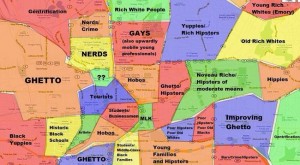
Annotated Bibliography #6
Felton, Carly. “Atlanta Intown .” Transformation of East Lake.Springs Publishing LLC, 01 Aug 2009. Web. 20 Feb 2016. <http://www.atlantaintownpaper.com/2009/08/the-transformation-of-east-lake/>.
The Transformation at East Lake is an article published by Carly Felting, who discusses the stats that made East Lake neighborhoods such a poverty crazed and criminalized place to live in. it gives a great visual as to why, when and how to why Tom Cousins decided to embark on the journey to transforming East Lake Atlanta’s neighborhoods, these neighborhoods that were once filled with drug dealers and lords, Tom had a vision and though it is was quite risky, it was the greatest endeavor yet. This article would we great for research because it puts numbers into the equations for greater understanding as to how rough and tough these neighborhoods were before the transformation. There are also statements provided from those who were born and raised, or those who did the raising of their children there, stating that being born and subjected to this neighborhood, they never had a chance.
The article discusses the restoration of the golf course, building of new homes, and the transformation of the community, it is very detailed with numbers and it ends with stats showing the outcome of Tom Cousins attempt to making it greater, it shows in numbers the percentage of children and families who now have a chance.

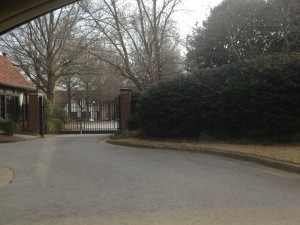
This is the entrance to the East Lake Golf Club which sits back away from the road. This entrance is gated and only allows members access. Through research I found out that membership is by invitation only through corporations, and there is no individual memberships available. The entrance is very subtle and private, leaving no mistakes to wander in.

As I wandered alongside the gates, I found two Caucasian older gentlemen playing golf. The course is very private so me hanging around probably arouse suspicion. Walking around I did not feel as if I belonged. The guys, on the other hand seem to be enjoying themselves in this windy, chill relaxed environment.
IMG_2456
Here is just a brief video clip of the golf course and the scenery it provides. In this clip, there is no sound. The only thing you can here is the wind rustling in the camera’s speaker piece. It was very quiet out which contributes to a very peaceful environment tucked away from the rest of the neighborhood. The only thing to listen to is the birds soaring across the sky and the squirrels ruffling in the trees above.
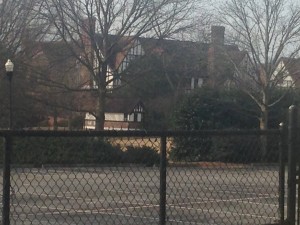
In this picture you can see the Golf Club house sitting upon a hill towards the back. It kind of gives a country feel with the trees blocking the view. The colors also contributes to the country atmosphere with the brown, forest green bushes and bare trees in the distance. It definitely is the highlight of the East Lake neighborhood.
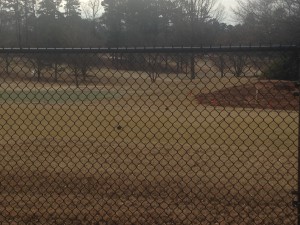

In these last photos, and every photo previously you can see how excluded the Golf Course is from the rest of the neighborhood. Fences surround the entire course. The area surrounding this is very closed in and private, the fences seem to provide more purpose than keeping the golfers balls from wandering outside the perimeters but it ensure no loitering or mistaken wandering access. The grass is very well kept, trimmed to perfection.
Description of East Lake Neighborhood (Golf Course)
As I observed the Golf course and its surroundings. I could really understand how it would be the highlight of the neighborhood. It is the oldest golf course of Atlanta, established in the beginning of 1904. It is in the East part of downtown Atlanta in East Lake neighborhood. It is a very well kept club house surrounded by nicely remodeled houses. Although the grass is not the greenest at this time of year, it creates a country feel with crisp cold breeze in the air with the smell of fresh cut grass.
The golf course sits away from the road with a gated entrance way leading to the club house that sits at the top of a hill being seen from the road but unfortunately not accessible unless you have a membership, which is by invitation only. It seems to only be useful to the elite class of people being that there only seemed to be older white guys playing golf on a Sunday afternoon.
From the look of the neighborhood, this golf course is not intended for regular individuals as myself, so walking around viewing the scenery made me feel out of place even though I was not in a place of danger. I received awkward stares that made me want to hurry and leave, but that’s when I realized that this is what I was here for: to find the exclusions where we think there are none.
As I got ready to leave the course, I realized how once I left the vicinity of the golf course, there were several black children and adults with their children at the nearby park that wasn’t as well kept. Although they seem to be having quite some fun. The park wasn’t the worst but it seemed to be in different world than the golf club, though it was barley around the corner. The benches were rusted with paint wearing away, and knocked over trash cans and such. The environment took a complete turn that I did not expect.


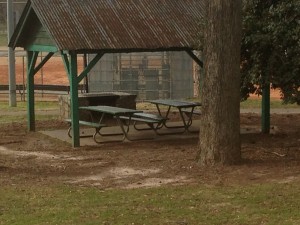
Annotated Bibliography 1:
“An Atlanta Neighborhood Tries To Redefine Gentrification.”Frontiers of Race, Culture and Ethnicity. Code Switch, 23 Sep 2015. Web. 04 Feb 2016. <http://www.npr.org/sections/codeswitch/2015/09/23/435293852/an-atlanta-neighborhood-tries-to-redefine-gentrification>.
This article discusses how the east lake golf club that sits in a neighborhood that once was in the middle full of crime, poverty and public housing projects ,and a Golf course with dry patchy land where golfers risked the case of a stray bullet, but is now a PGA tour stop due to the redevelopment and Golf Club. The neighborhood was so full of trouble and crime that it was known as the war zone and nick named “Little Vietnam”. It discusses how the crime rate was 18 times the national average. The article talks about how the golf club helped reestablish the community by being a source of funds and support. Although the intentions of the reconstruction was to create mixed-income housing to go along with schools, child care and jobs of quality article discusses how the some people were forced out of the new found transformed neighborhood due to certain requirements.
I think this article is important because it gives insight from the residents who once belonged to that community before the gentrification. This article provides so much history on what East Lake neighborhoods were like and how deprived and forsaken they were. It provides information on how the changes began and the effects of those changes. Whether good or bad, it gave testimonies on how it affected those looking for a stable safe place to live and raise families and also those who were forced to remove themselves due to those new requirements.
Annotated Bibliography 2:
Deirdre A. Oakley. “ASA Footnotes: A Publication of American Sociological Association.” Annual Meeting Premieres The Atlanta Way: A Documentary on Gentrification. ASA, Jul 2010. Web. 2 Feb 2016. <http://www.asanet.org/footnotes/julyaugust10/am_0710.html>.
This article is a profound one.it talks about the first premiere of the documentary. It also discusses the contradictory effects of the gentrification of the Atlanta neighborhoods that has been taken place and causing the predominantly poor black neighborhoods more suitable for affluent white people who can afford the upgraded living areas. It had great details about the purpose of the film with several interviews including Professor Deirdre A. Oakley. She expressed her opinion with great knowledge of what has been taking place in Atlanta residence. She summarizes her views of how this is creating a less diverse environment and how one sided the benefits are for those who can afford to remain or move to Atlanta.
She gives details and information about the writer of the film, King Williams in an interview segment that wouldn’t likely be found anywhere else.it allowed him to tell his story and give us a view of what was in his mind when he created the film and what inspired him to do so.
This article is a great resource for capturing the highlights of the film and to get insight on what gentrification is and how homelessness and displacement occurred in our city. Through this site, there lies more information about gentrification and how it’s like a two sided coin and were only looking at the side that is turned up our way.
Annotated Bibliography 3:
Max Blau. “Creative Loafing.” Can Anyone Stop Atlanta’s Gentrification. 13 Feb 2015. Web. 04 Feb 2016. http://clatl.com/freshloaf/archives/2015/02/03/can-anyone-stop-atlantas-rapid-gentrification.
Can Anyone Stop Atlanta’s Gentrification is a detailed article that has maps describing and illustrating the gentrification process since the 1990s and now the most recent map of 2015. The maps are vivid, well researched and informative.
The article provides a lot of documentation on what has been happening nationally to gentrify our cities. The author states that gentrification is happening but it is also causing our neighborhoods to become more affluent driving out the previous residents that were predominantly black. The article begs the question of what is actually happening to those who previously resided in these project homes now turned lofts and condos. This also leaves us to the bigger question, is this really a good thing and if possible is there any way to stop the gentrification. This article has statements from Mayor Kasim Reed and other government officials and their views of the rapid gentrification.
This source provides helpful information on the gentrification and illustrations showing how Atlanta is gentrifying twice as fast than any other city in America. It also discusses census data for 50 of the nation’s largest cities, which was published by Governing This Month.
